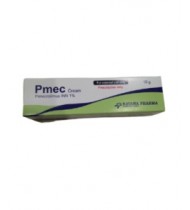Pimecrolimus
Indications
Pimecrolimus Cream is indicated as second-line therapy for the short-term and non-continuous chronic treatment of mild to moderate atopic dermatitis in non-immunocompromised adults and children 2 years of age and older, who have failed to respond adequately to other topical prescription treatments, or when those treatments are not advisable.
Pimecrolimus Cream is not indicated for use in children less than 2 years of age.
Pimecrolimus Cream is not indicated for use in children less than 2 years of age.
Pharmacology
Pimecrolimus is a macrolactam and is a derivative of ascomycin. It is an immunosuppressant which inhibits the activation of T-cells and prevents the release of inflammatory mediators from mast cells. It is used for the short term or intermittent long term treatment for mild to moderate atopic eczema.
The mechanism of action of pimecrolimus in atopic dermatitis is not known. While the following have been observed, the clinical significance of these observations in atopic dermatitis is not known. It has been demonstrated that pimecrolimus binds with high affinity to macrophilin-12 (FKBP-12) and inhibits the calcium-dependent phosphatase, calcineurin. As a consequence, it inhibits T cell activation by blocking the transcription of early cytokines. In particular, pimecrolimus inhibits at nanomolar concentrations Interleukin-2 and interferon gamma (Th1-type) and Interleukin-4 and Interleukin-10 (Th2-type) cytokine synthesis in human T-cells. In addition, pimecrolimus prevents the release of inflammatory cytokines and mediators from mast cells in vitro after stimulation by antigen/IgE.
The mechanism of action of pimecrolimus in atopic dermatitis is not known. While the following have been observed, the clinical significance of these observations in atopic dermatitis is not known. It has been demonstrated that pimecrolimus binds with high affinity to macrophilin-12 (FKBP-12) and inhibits the calcium-dependent phosphatase, calcineurin. As a consequence, it inhibits T cell activation by blocking the transcription of early cytokines. In particular, pimecrolimus inhibits at nanomolar concentrations Interleukin-2 and interferon gamma (Th1-type) and Interleukin-4 and Interleukin-10 (Th2-type) cytokine synthesis in human T-cells. In addition, pimecrolimus prevents the release of inflammatory cytokines and mediators from mast cells in vitro after stimulation by antigen/IgE.
Dosage & Administration
Apply a thin layer of Pimecrolimus Cream, 1% to the affected skin twice daily. The patient should stop using Pimecrolimus Cream, 1% when signs and symptoms (e.g., itch, rash and redness) resolve and should be instructed on what actions to take if symptoms recur.
If signs and symptoms persist beyond 6 weeks, patients should be re-examined by their health care provider to confirm the diagnosis of atopic dermatitis.
Continuous long-term use of Pimecrolimus Cream, 1% should be avoided, and application should be limited to areas of involvement with atopic dermatitis
The safety of Pimecrolimus Cream, 1% under occlusion, which may promote systemic exposure, has not been evaluated. Avoid use of Pimecrolimus Cream, 1% with occlusive dressings.
If signs and symptoms persist beyond 6 weeks, patients should be re-examined by their health care provider to confirm the diagnosis of atopic dermatitis.
Continuous long-term use of Pimecrolimus Cream, 1% should be avoided, and application should be limited to areas of involvement with atopic dermatitis
The safety of Pimecrolimus Cream, 1% under occlusion, which may promote systemic exposure, has not been evaluated. Avoid use of Pimecrolimus Cream, 1% with occlusive dressings.
Interaction
Potential interactions between Pimecrolimus Cream, 1% and other drugs, including immunizations, have not been systematically evaluated. Due to low blood levels of pimecrolimus detected in some patients after topical application, systemic drug interactions are not expected, but cannot be ruled out. The concomitant administration of known CYP3A family of inhibitors in patients with widespread and/or erythrodermic disease should be done with caution. Some examples of such drugs are erythromycin, itraconazole, ketoconazole, fluconazole, calcium channel blockers and cimetidine.
Contraindications
Pimecrolimus Cream, 1% is contraindicated in individuals with a history of hypersensitivity to pimecrolimus or any of the components of the cream.
Side Effects
Common side effects include headache, common cold or stuffy nose, sore throat, cough flu (influenza), fever, viral infection. Some people may get viral skin infections (like cold sores, chicken pox, shingles, or warts) or swollen lymph nodes (glands).
Pregnancy & Lactation
Pregnancy Category C. There are no adequate and well-controlled studies with Pimecrolimus Cream, 1% in pregnant women. Therefore, Pimecrolimus Cream, 1% should be used during pregnancy only if the potential benefit justifies the potential risk to the fetus. It is not known whether this drug is excreted in human milk. Because of the potential for serious adverse reactions in nursing infants from pimecrolimus, a decision should be made whether to discontinue nursing or to discontinue the drug, taking into account the importance of the drug to the mother.
Precautions & Warnings
- Should not be used in immunocompromised adults and children, including patients on systemic immunosuppressive medications.
- Avoid treatment on malignant or pre-malignant skin conditions, as these can present as dermatitis.
- Should not be used in patients with Netherton's Syndrome or skin diseases with a potential for increased systemic absorption.
Therapeutic Class
Drugs affecting the immune response
Storage Conditions
Keep below 30°C temperature, away from light & moisture. Keep out of the reach of children.
Pmec Cream 10 gm tube
IndicationsPimecrolimus Cream is indicated as second-line therapy for the short-term and non-continu..
1,000.00Tk.
Showing 1 to 1 of 1 (1 Pages)

